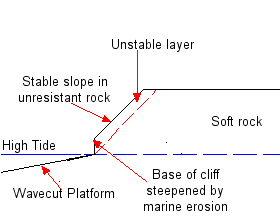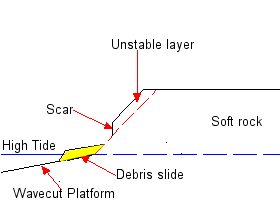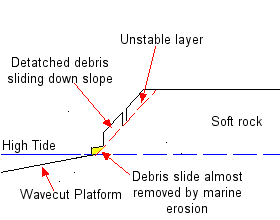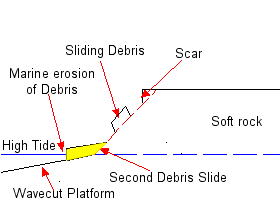Cliff retreat in soft rock.
Please start at Evolution.html
Conditions:
(a) Sea level is stable.
(b) Marine erosion takes place at the foot of the cliff between mean high tide and low tide level.
(c) The rock is only mechanically strong enough to support a stable slope of 45 degrees.
(d) The rock is fine grained and does not produce much beach material. The fine grains are carried out to sea in suspension.
(e) The dominant type of mass action triggered by marine erosion is shallow slides. (It could of course be slumps and falls)
(f) The cliff is relatively short - so that all the slides can reach the bottom of the cliff and be eroded before the parent rock is again attacked by marine erosion.
Explanation of the simulation:
(a) The slope of 45 degrees in unresistant rock is eroded and steepened.
(b) This makes the unresistant rock near the foot of the cliff unstable.
(c) A shallow slide is triggered off and material is removed to the bottom of the cliff.
(d) Marine erosion removes the debris brought by sliding to the foot of the cliff.
(e) Further shallow slides are triggered off further up the cliff and move towards the foot of the cliff.
(f) These slides bring material to the foot of the cliff as fast as the sea is removing it.
(g) In this way a layer of uniform thickness is removed from the initial slope that retreats parallel to itself maintaining its original gradient.
(h) The whole process is repeated over and over again.
The process is illustrated in the sequence of diagrams below:
Stage 1.

Stage 2.

Stage 3.

Stage 4.

If the initial slope is long then it is clear that the time for material to slide from the top of the cliff to the bottom assumes significance. The sea may begin cliffing the parent rock again before the slides from the top of the cliff reach the bottom. This triggers a second sequence of slides that work their way up the cliff below the earlier sequence. It does not affect the type of slope evolution: the parallel retreat of a cliff of constant overall gradient - the gradient being determined by the mechanical strength of the rock.
|



